The living room transforms into something magical during the Christmas season. It becomes more than jus a space—it evolves into the beating heart of holiday celebrations, where memories are made and traditions come alive.
Creating a cozy Christmas living room isn’t simply about tossing a few decorations around; it’s about crafting an atmosphere that wraps everyone in comfort while still maintaining that festive sparkle we all crave during the holidays.
Whether you’re working with a sprawling space or a snug apartment corner, the perfect balance of warmth and festivity can transform any living room into a Christmas haven. In this guide, we’ll explore 21 thoughtful approaches to creating that perfect cozy Christmas environment—one that’ll make your guests reluctant to leave and have you enjoying every moment spent there.
The Psychology Behind Cozy Spaces: Why It Matters During Holidays
Have you ever wondered why some Christmas gatherings feel more special than others? Often, it’s not just the company or the food—it’s the environment. Research from the Journal of Environmental Psychology suggests that our surroundings can significantly impact our mood, with cozy environments triggering the release of oxytocin, the “bonding hormone” that enhances social connections.
The Danish concept of “hygge” (pronounced hoo-gah) has gained worldwide attention for good reason. This philosophy celebrates coziness, comfort, and contentment—precisely what we aim for during the holiday season. According to Meik Wiking, CEO of the Happiness Research Institute in Copenhagen and author of “The Little Book of Hygge,” this concept isn’t just about aesthetic; it’s about “creating a warm atmosphere and enjoying the good things in life with good people.”
“The art of creating intimacy with yourself, others and your home. Hygge is about feeling safe and secure, so you can let your guard down.” — Meik Wiking
Interestingly, a survey by HomeGoods found that 93% of Americans believe their mood is positively affected by their home environment, with this effect amplified during festive periods. This connection between space and emotional wellbeing becomes especialy significant during Christmas when expectations and emotions already run high.
The nostalgic elements of Christmas decor also play a crucial psychological role. Studies show that nostalgia can actually combat feelings of loneliness and anxiety—making those vintage ornaments and traditional decorations more than just pretty items—they’re emotional anchors that ground us during the busy holiday season.
Setting the Foundation: Creating Your Base Cozy Canvas
1. Strategic Furniture Arrangement for Maximum Holiday Flow

Before adding a single decoration, consider how people will move and gather in your space. The most welcoming Christmas living rooms feature conversation areas that naturally draw people together. Try angling your sofa and chairs slightly toward each other instead of pointing everything at the TV—this simple change encourages face-to-face interaction.
For larger gatherings, create multiple seating clusters rather than one large arrangement. This allows smaller conversations to happen simulatenously without feeling disconnected from the larger group. Use ottomans and floor pillows as flexible seating options that can be moved around as needed.
Don’t forget to consider sightlines to your Christmas focal points. Everyone should be able to enjoy the tree, fireplace, or whatever serves as your room’s festive centerpiece without craning their necks.
Tip: Keep pathways at least 30 inches wide to allow easy movement, even with extra guests. Remember to create a designated gift-opening area that won’t block traffic flow on Christmas morning.
2. The Color Psychology of Christmas Comfort
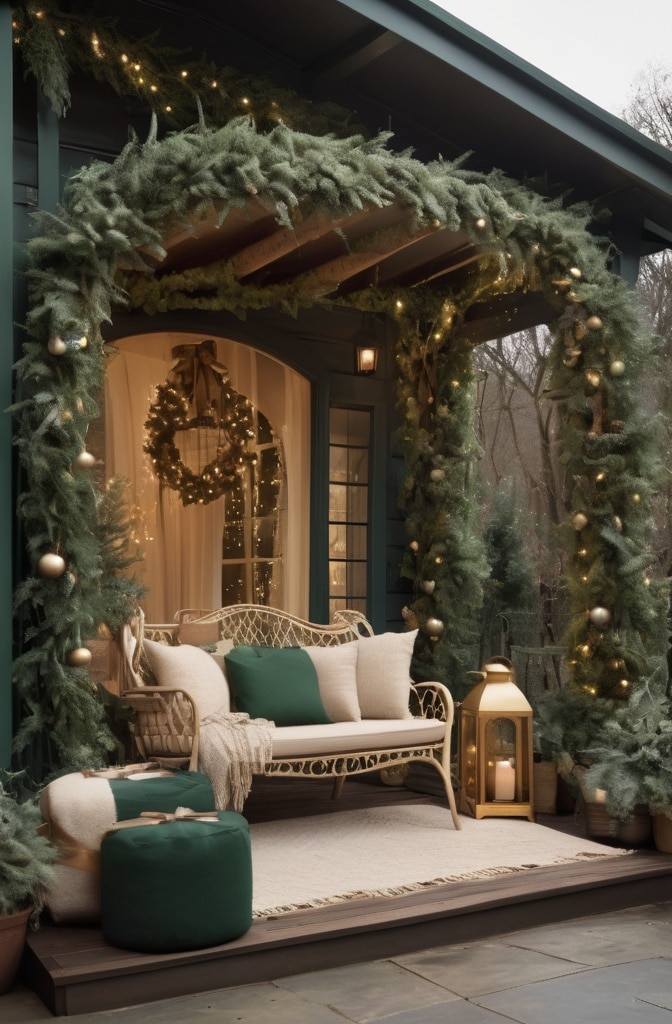
While red and green reign supreme in Christmas decor, psychologists note that an all-traditional color scheme can sometimes feel overwhelming or even stimulating rather than relaxing. Interior designer Sarah Richardson suggests, “Start with a neutral base and layer in festive colors for balance.”
Consider a more sophisticated take on Christmas colors:
- Deep burgundy instead of bright red
- Forest or sage green rather than emerald
- Winter white and cream as base colors
- Metallics like copper, bronze, or champagne gold instead of bright gold
Research on color psychology suggests that neutrals promote feelings of calm, while strategic pops of bold color create energy and excitement—the perfect balance for a cozy yet festive space.
For small living rooms, design experts recommend limiting your palette to 3-4 colors maximum to prevent visual chaos. In larger spaces, you can introduce more variation while maintaining cohesion through repeated color motifs throughout the room.
Lighting: The Soul of Christmas Coziness
3. Layered Lighting Techniques for Maximum Ambiance
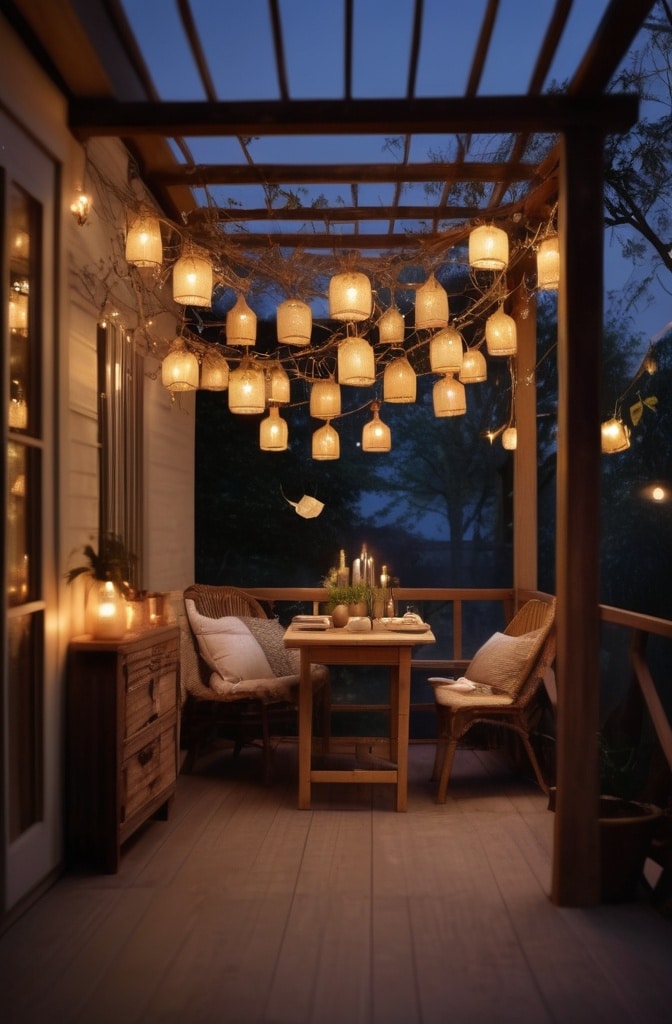
Nothing kills cozy Christmas vibes faster than harsh overhead lighting. Lighting designer Randall Whitehead recommends a minimum of three light sources in any room to create proper ambiance, but during Christmas, you might want to add even more layers.
Create a comprehensive lighting plan with:
- Ambient lighting: Dimmable overhead lights or recessed lighting on low settings
- Task lighting: Reading lamps or sconces for functional areas
- Accent lighting: Highlighting decor elements through spotlights or directional fixtures
- Decorative lighting: String lights, candles, and special holiday fixtures
A study from the Lighting Research Center at Rensselaer Polytechnic Institute found that warm light (2700-3000K) promotes relaxation, while cooler light (4000K+) increases alertness. During Christmas gatherings, aim for the warmer end of the spectrum to enhance that cozy feeling.
4. Beyond Fairy Lights: Unexpected Christmas Lighting Ideas

While fairy lights remain a Christmas essential, thinking beyond the standard string opens up endless creative possibilities. Interior stylist Emily Henderson suggests, “Try clustering multiple strands in glass containers for concentrated light sculptures that create dramatic focal points.”
Some creative alternatives to explore:
- Light-up branch arrangements in tall vases
- Projection lights that cast subtle snowflake patterns on walls or ceilings
- Paper star lanterns suspended at varying heights
- Moroccan-style metal lanterns with holiday-scented candles
- LED-illuminated canvas artwork with winter scenes
For homes with children and pets, flameless candles have become increasingly sophisticated. Many now feature moving “flames” and can be controlled via remote or smartphone apps, allowing you to adjust brightness or set timers without sacrificing the authentic ambiance.
Safety expert Jennifer Hoover reminds us, “Always keep combustible decorations at least three feet from heat sources, and never leave real candles unattended, even for a minute.”
Textural Elements: The Touchable Christmas
5. Textile Layering Masterclass for Ultimate Comfort
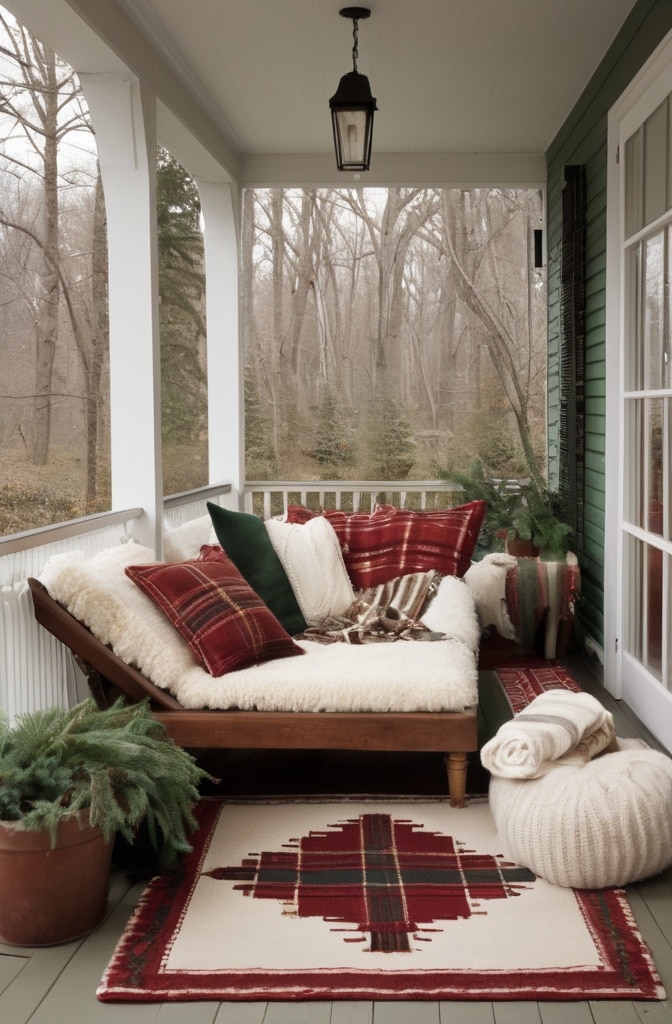
Texture plays a critical role in creating percieved warmth—the kind you can see and feel. Interior designer Nate Berkus follows what he calls “the rule of three textures” in any cozy space: “Combine smooth, rough, and something with visual texture for the perfect balance.”
When applying this to your Christmas living room, you might combine:
- Smooth: Velvet pillows or satin ribbon accents
- Rough: Chunky knit throws or woven baskets
- Visual texture: Faux fur rugs or embossed wallpaper
Stategic placement matters as much as the textiles themselves. Place the softest items where people will directly interact with them—on the sofa, chairs, and underfoot in conversation areas. Reserve more decorative textures for visual impact in areas less likely to be touched.
Consider temperature fluctuations during gatherings. Having easily accessible throws allows guests to adjust their comfort level without changing the thermostat—both energy-efficient and considerate.
6. Unexpected Textures: Beyond Traditional Christmas Fabrics
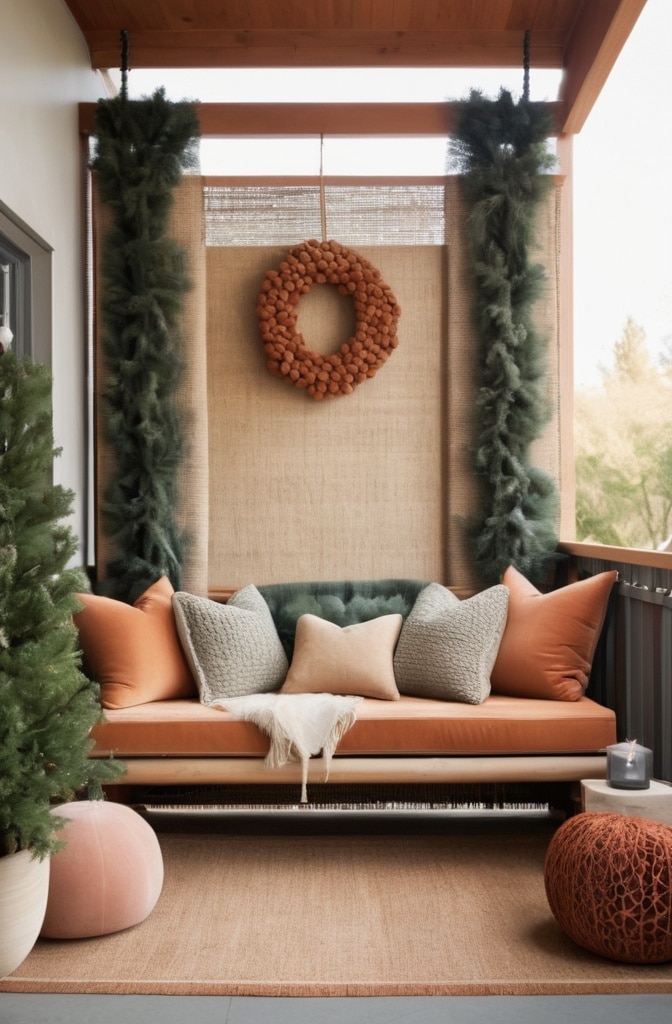
While plaid and velvet have their rightful place in Christmas decor, exploring unexpected textural elements can elevate your space from predictable to memorably cozy. This year, interior design trends show increased interest in bouclé, a nubby fabric with a looped texture that adds visual interest and tactile comfort.
Material combinations that create textural interest:
- Matte and shiny surfaces (concrete containers holding glossy ornaments)
- Natural and processed materials (wooden beads paired with metallic elements)
- Rough and smooth contrasts (burlap table runners atop polished wood)
DIY texture projects can add personal touch without excessive cost. Consider:
- Dip-dyeing plain white taper candles in festive colors
- Creating macramé ornaments or garlands
- Making wool-wrapped letters spelling holiday messages
Designer Kelly Wearstler notes, “Texture is what makes a space feel alive. It’s the element people respond to most viscerally, even if they don’t realize it.”
The Sensory Christmas Experience
7. Creating a Scent Story Throughout Your Living Space
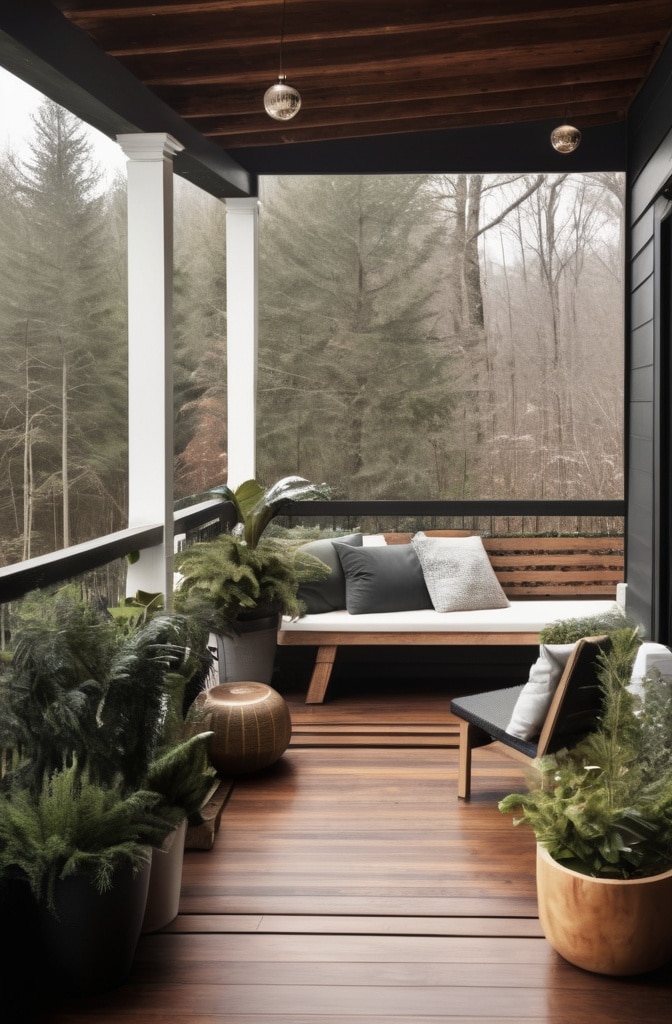
While visual elements dominate most Christmas decorating discussions, scent might be the most powerful sense for creating atmosphere. Neurologist Dr. Alan Hirsch explains, “Scents bypass the thalamus and go straight to the brain’s smell center, connecting directly to the limbic system and hippocampus, regions related to emotion and memory.”
Rather than relying on one overwhelming scent, create a layered “scent story” with:
- Base notes: Pine, cedar, sandalwood, or vanilla
- Middle notes: Cinnamon, clove, or nutmeg
- Top notes: Orange, cranberry, or peppermint
Natural scent elements that double as decor include:
- Orange pomanders studded with cloves
- Fresh evergreen garlands or wreaths
- Cinnamon stick bundles tied with ribbon
- Simmering stovetop potpourri (visible from the living room)
For those sensitive to fragrances, consider subtler options like beeswax candles, which emit a naturally gentle honey scent without added perfumes.
8. The Overlooked Element: Christmas Soundscapes
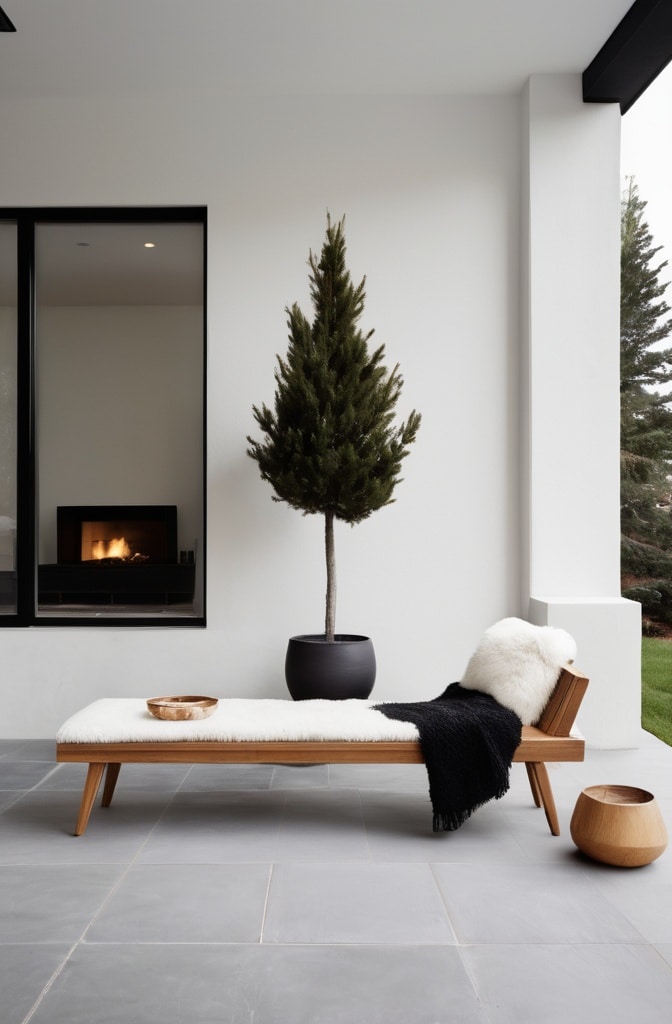
The auditory dimension of Christmas coziness often gets overlooked, yet it significantly impacts how comfortable people feel in your space. Beyond the typical holiday playlist, consider how sound functions within your environment.
Acoustic design principles worth considering:
- Soft surfaces absorb sound, creating a more intimate feeling
- Strategic rugs and textiles can reduce echo in rooms with hard flooring
- Background music should be kept at conversation level (around 70 decibels)
Create audio zones that allow for different experiences:
- A main living area with gentle background music
- A quieter conversation nook
- A more energetic space for children or lively discussions
Sound designer Bernie Krause suggests incorporating natural sounds: “The crackling of a real or simulated fire, the gentle tinkling of bells on the door, or even the soft bubbling of a simmer pot creates an immersive audio experience that enhances visual decor.”
Smart speaker systems can help create these zones without multiple stereo setups, with programmable volume levels and the ability to synchronize or differentiate music in various rooms.
Style-Specific Approaches to Cozy Christmas
9. Modern Minimalist: Clean Comfort for Contemporary Homes

Minimalism doesn’t mean sterile or cold, especially during Christmas. It’s about prioritizing quality over quantity and being intentional with every element. Architect John Pawson, known for his minimalist designs, explains, “Minimalism is not about emptiness; it’s about the beauty of fewer, perfectly chosen things.”
For a cozy minimalist Christmas, focus on:
- Limited color palette (perhaps just two contrasting colors plus neutrals)
- Statement decorative pieces rather than numerous small items
- Empty space as an intentional design element
- Textural variations within your chosen color scheme
Some minimalist-friendly Christmas elements:
- A simple arrangement of birch logs in a concrete planter
- A collection of varying height pillar candles on a plain surface
- A seamless garland of single-variety greenery without embellishment
- Monochromatic ornaments grouped by size rather than dispersed
Interior designer Shea McGee advises, “When working with a minimal aesthetic, increase the scale of fewer items rather than using many small decorations—one large, beautiful wreath makes more impact than ten small generic ones.”
10. Rustic Revival: Bringing Nature’s Comfort Indoors
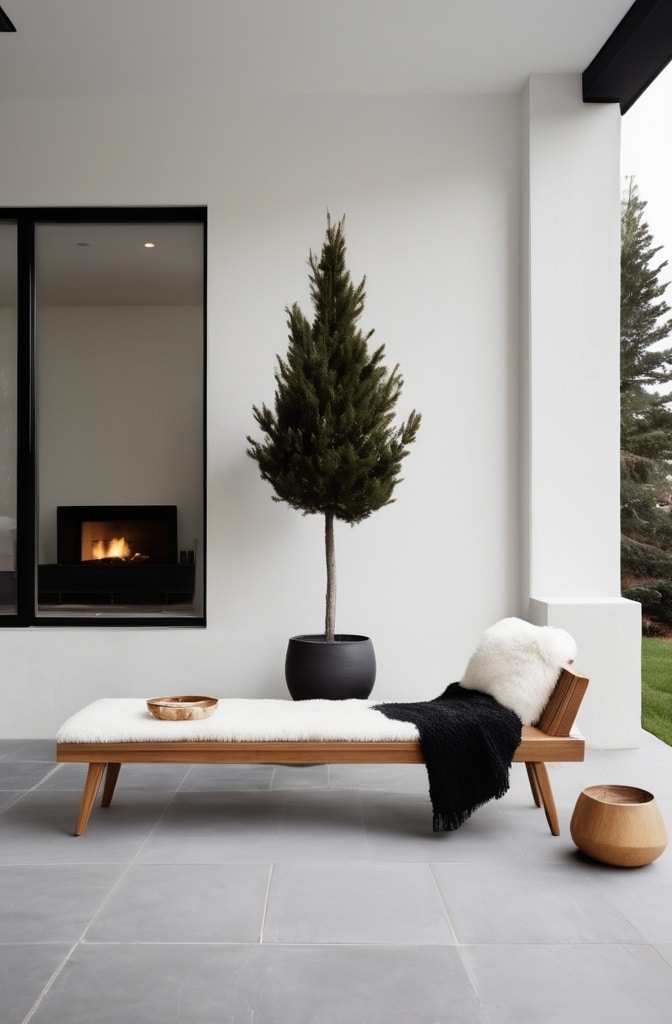
The rustic Christmas aesthetic celebrates imperfection and natural materials—a refreshing contrast to commercial perfection. This approach connects us to simpler times and brings the outdoors in during winter months when we might feel disconnected from nature.
Sustainable designer Emma Sims-Hilditch recommends “thoughtful foraging” for decor elements: “Gather fallen branches, pinecones, and evergreen trimmings from your own property or with permission from local land. Not only is this environmentally friendly, but it creates a genuine connection to your surroundings.”
To prevent your rustic decor from deteriorating before the season ends:
- Spray pinecones with a light coat of polyurethane to prevent shedding
- Mist evergreen arrangements daily and keep away from heat sources
- Seal sliced wood rounds with beeswax to prevent cracking
- Place water-filled containers out of sight for fresh-cut branches
When mixing raw and refined elements, maintain balance through repetition. If you use rough-hewn wood in one area, echo that material elsewhere in the room to create cohesion rather than contrast.
11. Scandinavian Simplicity: The Original Cozy Christmas

Scandinavian Christmas design has mastered the art of festive minimalism long before it became trendy elsewhere. This approach emphasizes natural materials, clean lines, and the contrst between light and dark elements—perfect for creating a cozy yet sophisticatd Christmas.
Key principles of Scandinavian Christmas design:
- Abundant use of white space and light-reflecting surfaces
- Natural materials like wood, wool, and linen
- Candlelight as a primary lighting source
- Restrained use of color (typically white, cream, gray with red accents)
Danish interior designer Niki Brantmark explains, “In Scandinavia, the dark winter necessitated making the most of available light. Our Christmas traditions revolve around creating warmth within that darkness—both literally and figuratively.”
Authentic Scandinavian decorations to incorporate:
- Paper star lights (stjernelys) hung in windows
- Straw ornaments and wooden figurines
- Advent candle arrangements (four candles in natural materials)
- Sheaves of wheat tied with simple ribbon
The Scandinavian approach reminds us that coziness comes from thoughtful simplicity rather than abundance—a valuable lesson during the sometimes overwhelming Christmas season.
12. Farmhouse Festivity: Country Comfort with Contemporary Edge
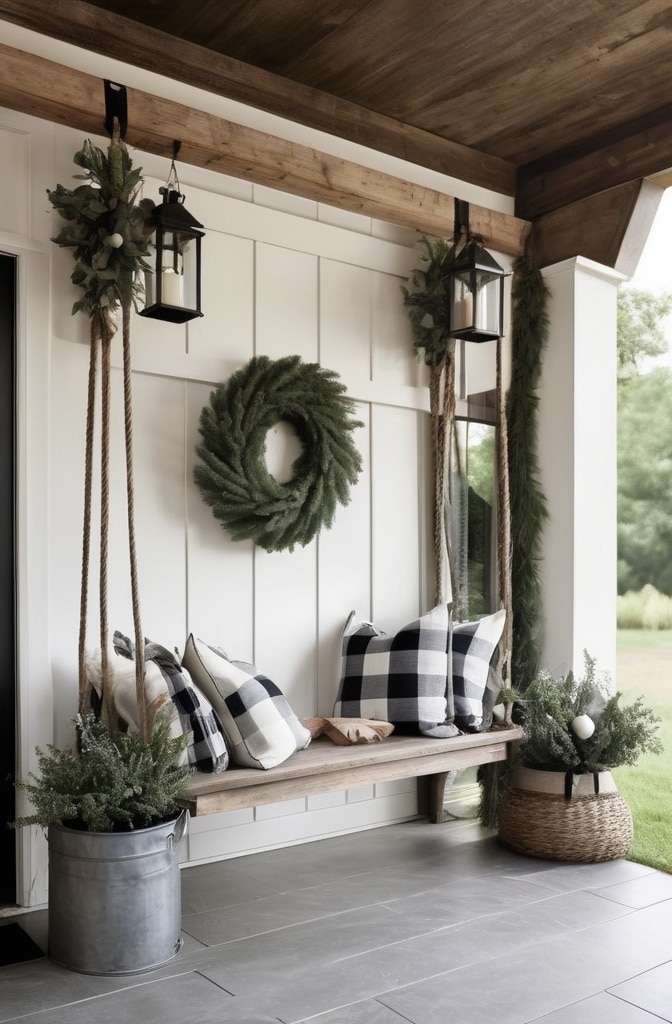
The modern farmhouse Christmas blends rustic charm with contemporary cleanlines, creating spaces that feel both timeless and current. This popular style works particularly well for Christmas decor because it naturally incorporates many elements we associate with holiday comfort—natural textures, nostalgic references, and unfussy elegance.
Designer Joanna Gaines, who popularized the modern farmhouse look, suggests, “Mix old and new elements freely. Vintage ornaments displayed in a modern container create the perfect tension between nostalgia and freshness.”
Signature elements of farmhouse Christmas style:
- Galvanized metal containers filled with greenery
- Black and white buffalo check paired with red accents
- Repurposed vintage items as unexpected decorations
- Handmade elements alongside refined pieces
When executing this look, avoid overly distressed items that can make the space feel contrived. Authentic farmhouse style embraces natural wear but doesn’t manufacture an artificial sense of age.
Practical Solutions for Common Challenges
13. Small Space Solutions: Big Holiday Impact in Limited Square Footage
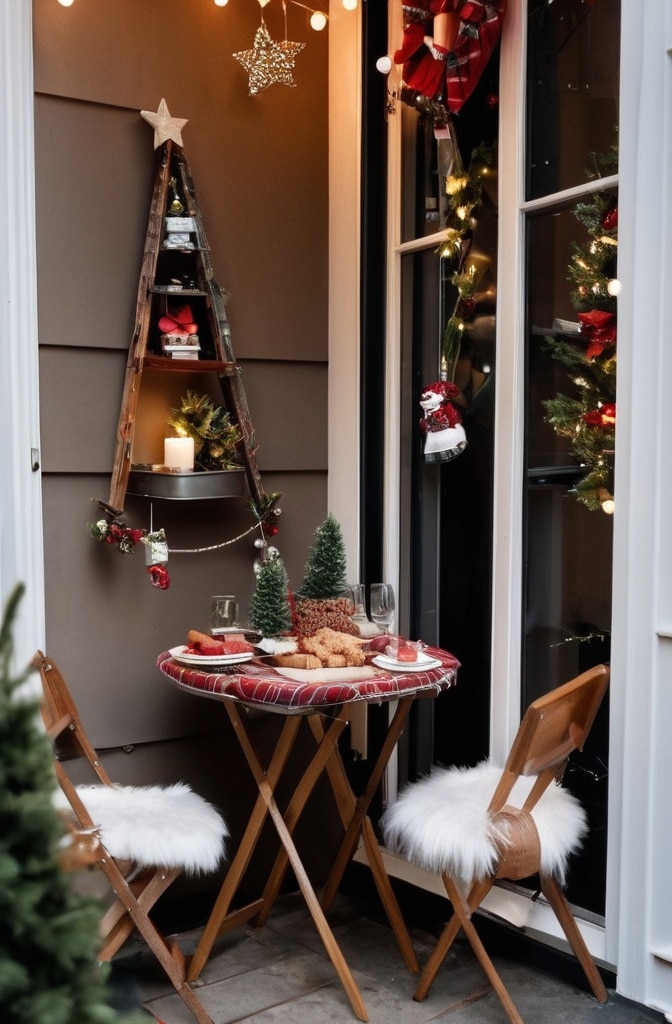
Small living rooms require strategic decorating to achieve maximum coziness without crossing into cluttered territory. Interior designer Maxwell Ryan of Apartment Therapy recommends, “In small spaces, go up, not out. Use your vertical real estate for decorating while keeping floor space open.”
Space-maximizing strategies include:
- Wall-mounted or hanging greenery instead of full-size trees
- Projected light displays instead of physical decorations
- Door and window decorations that don’t consume floor space
- Multi-functional decor (like ornament-filled hurricane lamps that serve as table lighting)
Optical illusions can also make your space feel larger:
- Mirrors positioned to reflect Christmas lights and candles
- Clear or transparent decorative elements that don’t visually take up space
- Monochromatic color schemes with subtle variations of the same hue
- Strategic lighting that highlights ceiling height
Remember that in small spaces, editing is your most powerful tool. Ask yourself if each decoration serves a purpose (aesthetic or functional) and if multiple items could be combined or simplified.
14. Budget-Friendly Approaches That Don’t Sacrifice Style
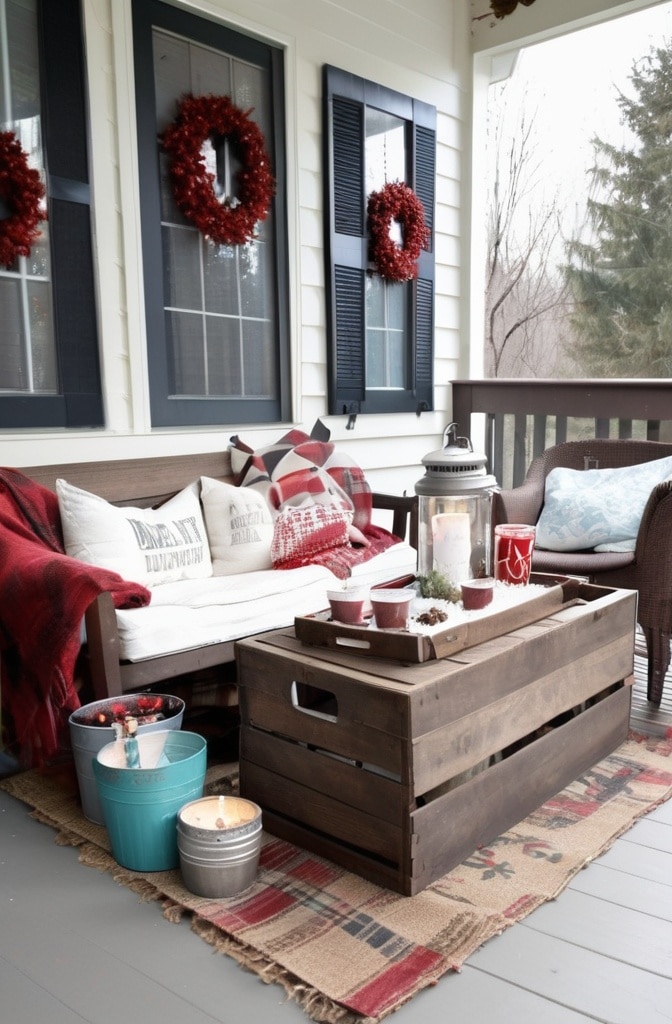
Creating a cozy Christmas atmosphere doesn’t require emptying your wallet. Interior stylist Emily Henderson notes, “Some of the most memorable Christmas decorations are the ones with stories and personality—things you can’t necessarily buy at a store.”
Cost-effective approaches that still look high-end:
- Natural elements gathered from outdoors (free!)
- Thrifted glassware filled with inexpensive string lights
- DIY fabric garlands from scrap material or old clothing
- Baked goods as both activity and decoration
Strategic splurging helps maximize impact. Invest in:
- One statement piece that anchors your decorating scheme
- Quality lighting that can be reused for years
- Versatile basics in neutral colors that can work beyond Christmas
Consumer expert Andrea Woroch suggests, “Shop post-season sales for next year’s decorations. Items discounted 70-90% after Christmas can transform next year’s decor budget from modest to magnificent.”
15. Pet and Child-Friendly Christmas Coziness

Creating a cozy Christmas living room that’s also safe for all family members requires thoughtful planning. Veterinarian Dr. Carol Osborne warns, “Many traditional Christmas plants like poinsettias, holly berries, and certain types of pine can be toxic to pets if ingested.”
Child and pet-safe alternatives include:
- Artificial plants placed out of reach (or real plants specifically researched for safety)
- Shatterproof ornaments on lower tree branches
- Battery-operated flameless candles instead of real flames
- Securely anchored decorations that resist tugging or knocking over
Washable elements help maintain beauty despite accidents:
- Slipcovers in festive colors for vulnerable furniture
- Indoor/outdoor rugs that can be hosed down if needed
- Fabric decorations that can go in the washing machine
- Wipeable surfaces for high-traffic areas
Interior designer and mother of three Amber Lewis advises, “Create a dedicated ‘kid zone’ with their own decorations they can manipulate freely. This reduces the temptation to play with more delicate items elsewhere.”
Focal Point Development: The Anchors of Christmas Charm
16. Beyond the Tree: Alternative Christmas Focal Points
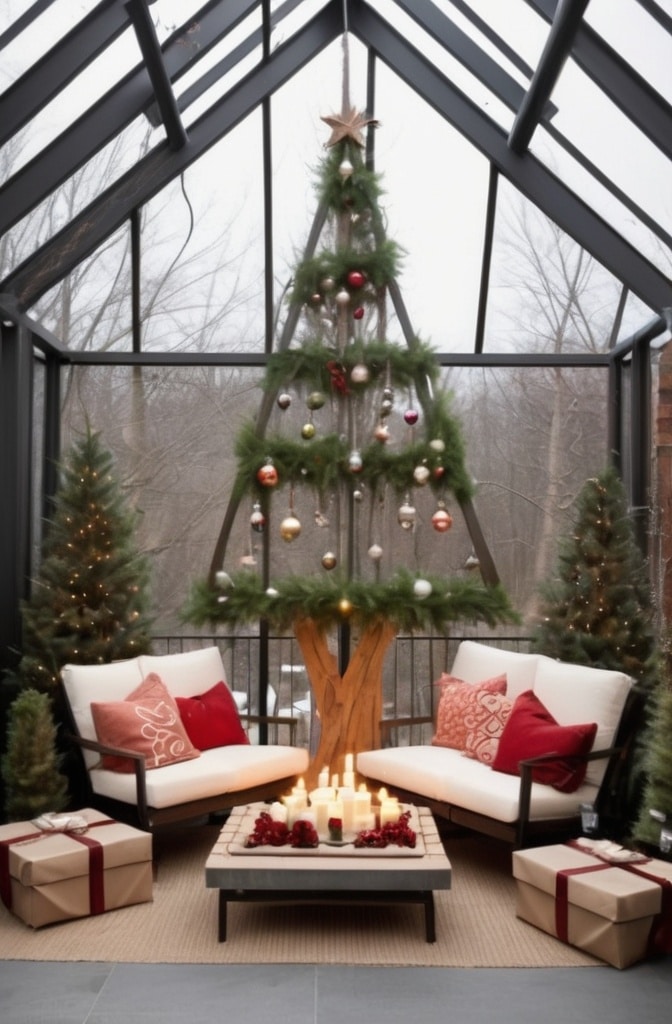
While Christmas trees traditionally serve as living room focal points, alternative options can be equally effective—particularly in smaller spaces or for those seeking something different. Interior designer Kelly Wearstler encourages thinking beyond tradition: “A focal point should be a conversation starter that draws people in and makes them feel something.”
Window treatments can become stunning focal points:
- Full-length curtains in rich, festive fabrics
- Window film that creates stained-glass effects when backlit
- Suspended ornaments or paper snowflakes at varying depths
- Light projections that transform ordinary windows after dark
Wall installations make dramatic impact without consuming floor space:
- Gallery wall of vintage Christmas cards or artwork
- Suspended branch “chandeliers” adorned with lightweight ornaments
- Geometric holiday-themed wall hangings made from wood or fabric
- Shadow box displays of cherished ornaments or miniature scenes
For maximum impact, ensure your focal point has adequate negative space around it. Even the most beautiful feature loses effect when competing with too many surrounding elements.
17. The Modern Hearth: Creating Warmth Without a Fireplace
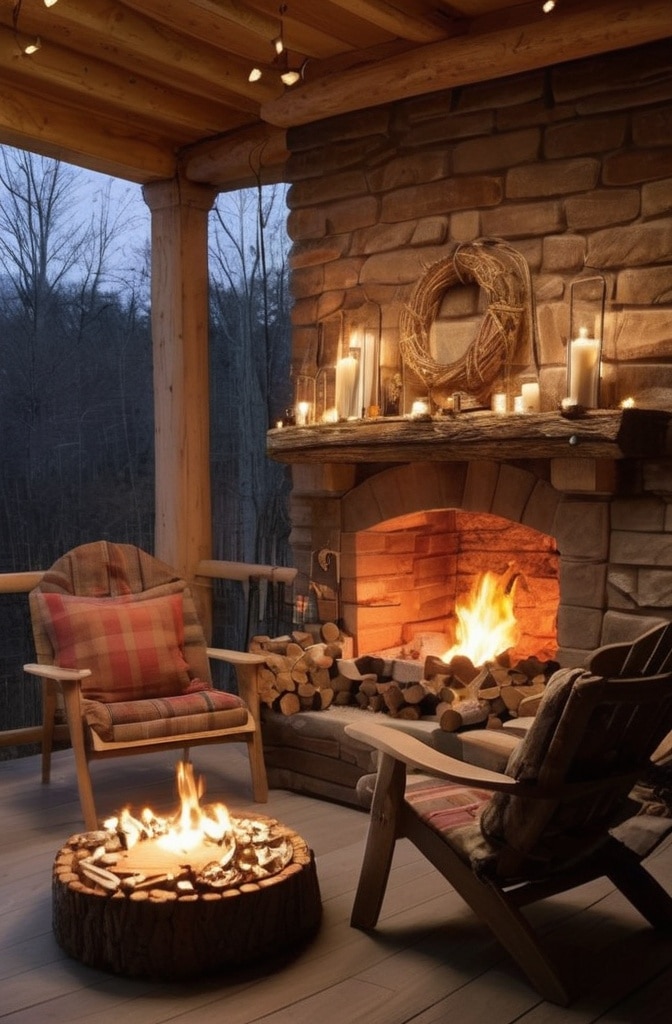
Not every living room comes equipped with a fireplace, yet that sense of gathering around a warm center remains central to Christmas coziness. Interior architect Nancy Snyder explains, “The concept of a hearth is more psychological than physical—it’s about creating a central point that draws people together.”
Fireplace alternatives that create similar ambiance:
- Electric fireplaces with realistic flame effects (some models don’t require ventilation)
- Candle groupings of varying heights arranged where a fireplace would be
- Vintage radiators repurposed as decorative elements with shelf space above
- Entertainment centers styled with warm lighting and natural elements
Creating a psychological hearth through furniture arrangement:
- Position seating to face a central point other than the TV
- Use area rugs to define a gathering space
- Create levels of interest with varying heights of decor and lighting
- Install wall sconces that frame your chosen hearth area
Designer Sarah Richardson suggests, “Even without flame, you can simulate firelight using amber-colored bulbs behind translucent screens or within frosted glass containers.”
Personalized Touches: Making Cozy Uniquely Yours
18. Heritage Displays: Incorporating Family History Into Your Decor
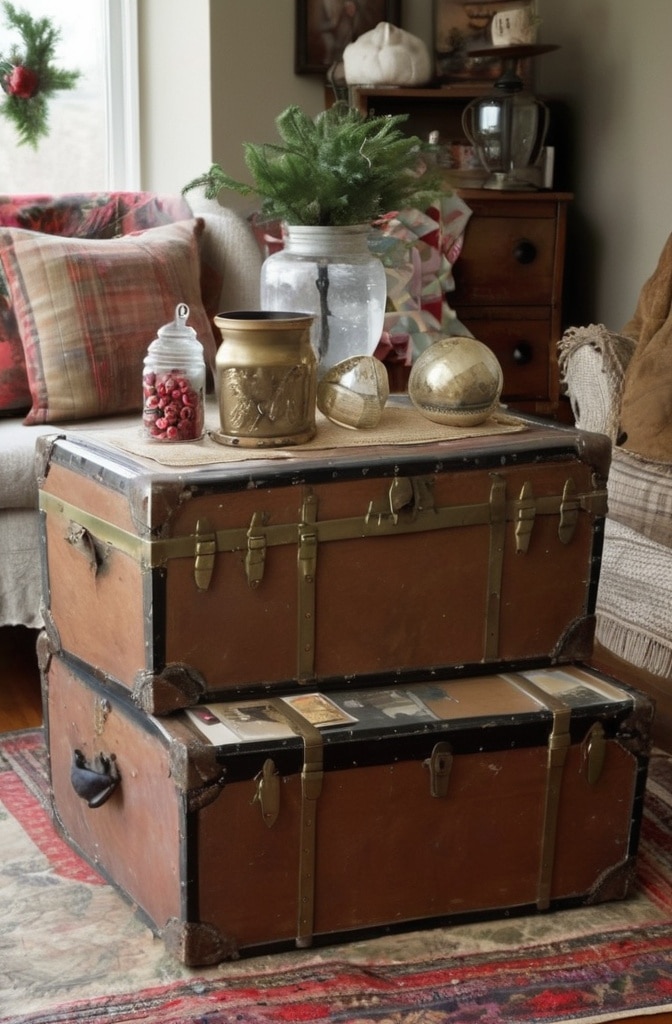
The most meaningful Christmas living rooms tell a story—specifically, your family’s story. Anthropologist Dr. Grant McCracken has studied the relationship between possessions and identity, noting that “objects with personal history connect us to our past and reinforce our sense of self and belonging.”
Effective ways to showcase heritage items:
- Group similar heirlooms together rather than scattering them
- Create dedicated memory zones with photographs and mementos
- Use shadow boxes to protect and highlight fragile vintage pieces
- Integrate family recipes into decor (framed cards or recipes screen-printed onto tea towels)
To preserve these special items for future generations:
- Document the stories behind heirloom decorations in a dedicated book
- Take annual photos of how they’re displayed to create a visual history
- Create archival storage solutions for when they’re not in use
- Consider creating replicas of extremely fragile items so originals can be preserved
Designer Nate Berkus reminds us, “Things matter. They have energy. They tell our stories. Displaying what has meaning to you will always create a more authentic space than following trends.”
19. Handcrafted Holiday: DIY Elements That Tell Your Story
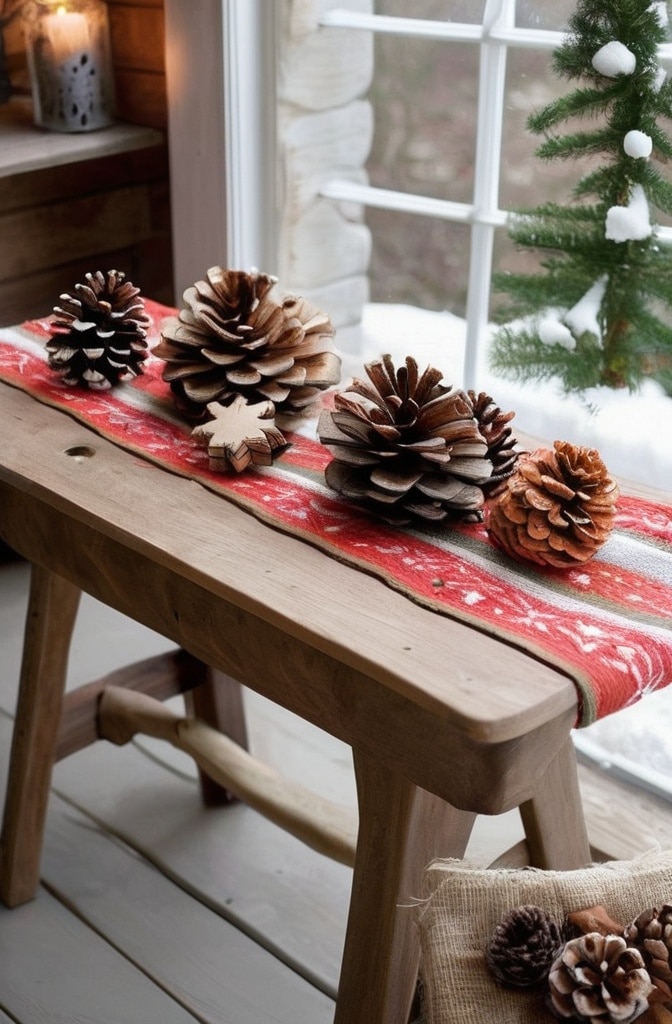
In an age of mass-produced everything, handmade elements bring soul to Christmas decorating. Craft expert Lia Griffith explains, “The imperfection in handmade items is precisely what makes them perfect—they carry the distinctive mark of their creator.”
Impactful DIY projects that require minimal artistic skill:
- Paper snowflakes made from old book pages or sheet music
- Citrus garlands (dried orange slices strung on twine)
- Hand-dipped beeswax candles in holiday colors
- Salt dough ornaments stamped with meaningful words or dates
Elevating homemade decorations to designer quality:
- Use high-quality materials even for simple projects
- Create multiples of the same item for greater impact
- Limit your color palette to create cohesion
- Combine handmade elements with more polished store-bought items
Family craft nights can become part of your holiday tradition, with new creations added to your collection each year. Designer Emily Henderson suggests dating each creation, noting, “Watching the progression of children’s handmade ornaments year after year becomes a visual growth chart of precious memories.”
Maintenance and Evolution
20. Keeping the Cozy Alive: Maintaining Your Space Throughout the Season

The Christmas season spans several weeks, and maintaining that initial cozy magic requires some effort. Professional stylist Edward Gaul notes, “Refreshing your space halfway through the season breathes new life into your decorations and keeps the environment feeling special.”
Mid-season refresh techniques:
- Swap tired greenery for fresh branches
- Rotate decorative elements between rooms for a change of scenery
- Introduce new scented elements as others fade
- Change your lighting arrangement to create different moods
For live elements like poinsettias and Christmas trees:
- Keep away from heating vents and direct sunlight
- Maintain consistent watering schedules
- Mist needle trees regularly to prevent premature drying
- Remove damaged elements promptly to prevent affecting surrounding decorations
Designer Jeffrey Alan Marks suggests, “Plan your initial decorating with evolution in mind. Include elements that can easily transition from early December through the New Year by swapping out minor details rather than overhauling everything.”
21. Post-Holiday Transition Strategies
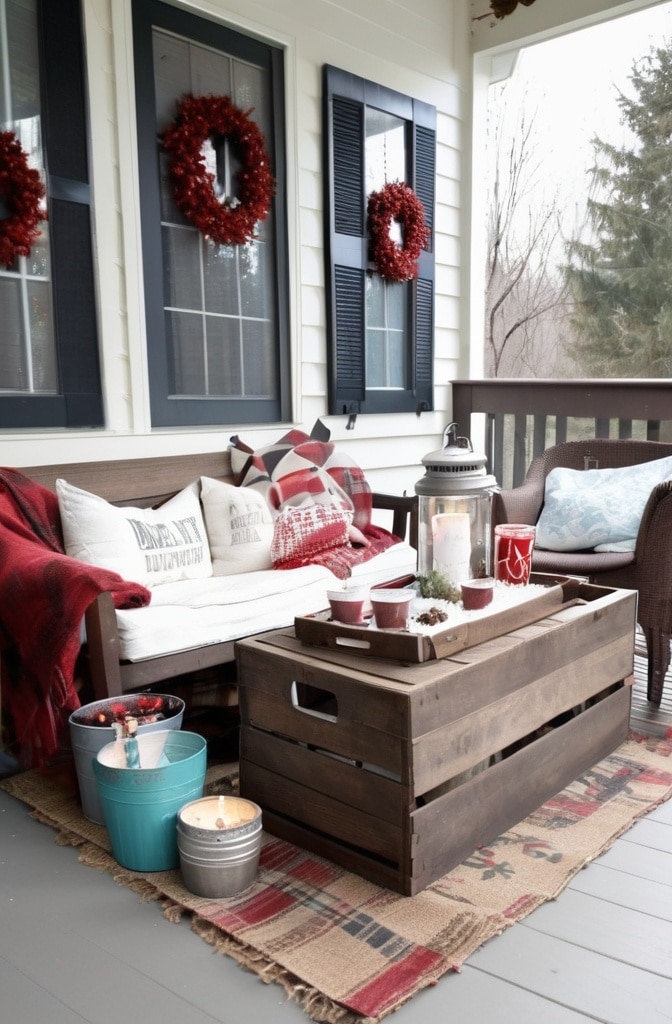
The post-Christmas period often feels emotionally and visually deflating as decorations come down. Interior stylist Emily Henderson recommends, “Rather than removing everything at once, transition gradually by keeping winter-themed rather than specifically Christmas elements.”
Elements worth keeping through winter:
- Fairy lights and candles for continued warm lighting
- Evergreen elements (minus obvious Christmas decorations)
- Cozy textiles in neutral colors
- White or silver decorative elements that suggest winter rather than Christmas
Storage solutions that preserve decorations:
- Acid-free tissue paper for wrapping delicate ornaments
- Clear containers organized by room or color theme
- Vertical ornament storage that prevents crushing
- Climate-controlled areas for temperature-sensitive items
This thoughtful takedown process not only preserves your decorations but also eases the psychological transition out of the holiday season.
Conclusion
Creating a cozy Christmas living room isn’t about achieving magazine-worthy perfection—it’s about designing a space where memories can take root and flourish. The most inviting holiday environments strike that delicate balance between festive energy and restful comfort, between tradition and personal expression.
As you implement these ideas, remember that the coziest Christmas spaces evolve organically over time, accumulating layers of meaning with each passing year. Start with the elements that speak most deeply to you, prioritizing comfort and authentic expression over perfectly coordinated design.
The true measure of success isn’t how your space photographs, but how it feels when filled with the people who matter most to you. After all, the warmest Christmas glow comes not from perfect string lights or ideal color schemes—but from the sense of belonging and connection that your thoughtfully created environment helps foster.
Resources
Recommended Suppliers:
- Terrain (www.shopterrain.com) – Exceptional natural and garden-inspired Christmas decor
- Food52 (food52.com/shop) – Unique handmade and small-batch holiday items
- Etsy (www.etsy.com) – Direct access to artisan-made Christmas decorations worldwide
Apps and Planning Tools:
- Pinterest – Create separate boards for different Christmas decorating styles
- Planner 5D – Test furniture arrangements before moving heavy pieces
- ColorSnap by Sherwin-Williams – Coordinate paint colors with existing decor
Further Reading:
- “Cozy: The Art of Arranging Yourself in the World” by Isabel Gillies
- “The Year of Cozy” by Adrianna Adarme
- “Hygge: The Danish Art of Happiness” by Marie Tourell Søderberg
